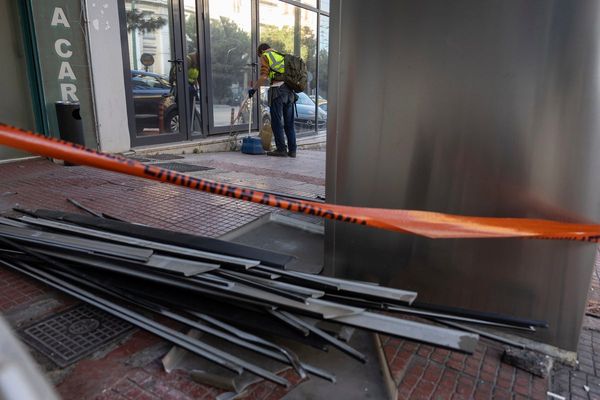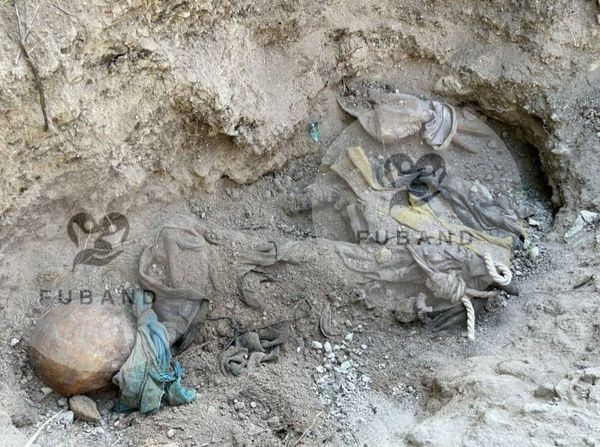
A London antiquities dealer has withdrawn an ancient Greek amphora from sale after evidence arose that links it to a notorious smuggler.
The Kallos Gallery in Mayfair, London, has removed a black-figure amphora – a jar with two handles and a narrow neck made around 550BC – from sale after the Observer contacted it about concerns raised by an expert in the illegal trade of antiquities.
Dr Christos Tsirogiannis, an archaeologist and leading expert in looted antiquities and trafficking networks, found evidence that led him to conclude the amphora probably came from an illicit excavation in Italy.
He spotted the amphora when the gallery offered it last month at Tefaf Maastricht, one of the world’s foremost art and antiques fairs, and matched it to a Polaroid photograph that appears to show the same object in the hands of Giacomo Medici, who was convicted in Italy in 2004 of dealing in stolen artefacts. That photograph was part of an archive seized from him by police and was on the website of the Italian Carabinieri.
The Dutch police have been notified. The object’s value is believed to be about £50,000.
The Kallos Gallery, which specialises in ancient art, was founded in 2014 by Baron Lorne Thyssen-Bornemisza, son of the late Baron Hans Heinrich von Thyssen Bornemisza, the Swiss billionaire who built up what was regarded as the greatest art collection in private hands in the world.
Measuring 23.6cm in height, the amphora is decorated with sphinxes, a ram and a lion. It is attributed to the artist known only as the Phineus Painter, named after a cup he decorated with the myth of Phineus, the blind king plagued by harpies and saved by Jason and the Argonauts.
The collecting history given by the gallery online only dated back to 1986. This raised Tsirogiannis’s suspicions that the jar could have been part of an illicit excavation, he said: “These are immediate red flags.”
He added that the provenance details included a gallery that had belonged to a dealer who was himself convicted for receiving stolen antiquities from Italy in the 1970s.
Tsirogiannis, an affiliated archaeology lecturer at the University of Cambridge, heads illicit antiquities trafficking research for the Unesco chair on threats to cultural heritage at the Ionian University in Corfu. The late Paolo Giorgio Ferri, the Italian public prosecutor who pursued and prosecuted traffickers in looted antiquities, gave Tsirogiannis access to tens of thousands of images and other archival material seized in police raids from traffickers and other individuals involved in the illicit trade.
Over 19 years, Tsirogiannis has identified more than 1,700 looted antiquities, alerting police and playing a role in their repatriation to 15 countries. The finds include an ancient Greek bronze horse that Sotheby’s New York intended to auction in 2018 until Tsirogiannis notified the authorities of its links to the British antiquities dealer Robin Symes. Greece claimed the horse as its national property, and in 2020 Sotheby’s lost its legal challenge, prompting the Greek culture minister to welcome the court’s ruling as a victory for countries seeking to reclaim their antiquities.
Last year, Christie’s withdrew ancient Greek vases from auction after Tsirogiannis discovered their link to another convicted antiquities trafficker. He criticised the auctioneer’s failure to reveal that the objects could be traced to Gianfranco Becchina, who was convicted in 2011 of illegally dealing in antiquities. Christie’s said at the time that it withdrew the works once it was made aware of the connection.
Tsirogiannis has identified many other Medici objects, which have been repatriated to Italy over the years. “Medici was receiving objects looted from tombs in Italy,” he said, adding that he believes the amphora came from Etruscan tombs in Italy.
He has repeatedly argued that auction houses and dealers do not make adequate checks with Greek and Italian authorities, and has criticised their failure to disclose objects’ full collecting history.
Madeleine Perridge, director of the Kallos Gallery, said: “We make every effort to do our due diligence and publish all collection and publication history known to us … The artwork in question has been immediately removed from sale pending advice from the relevant authorities. We have absolutely no interest in handling tainted artworks and welcome an opportunity to find practical and productive solutions to these complex issues.”







